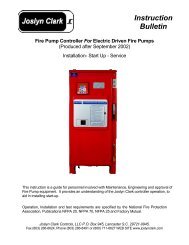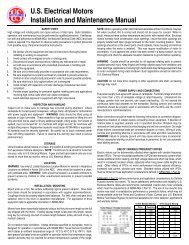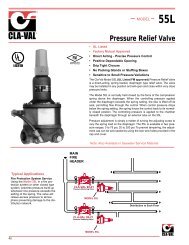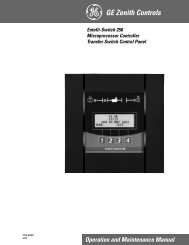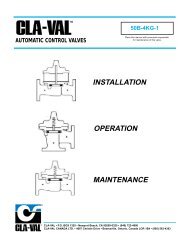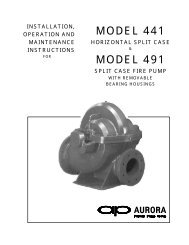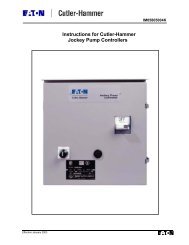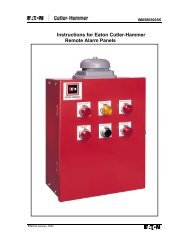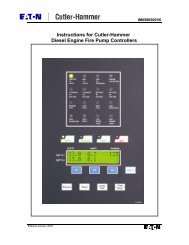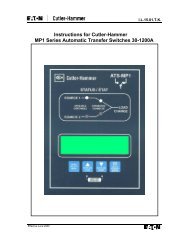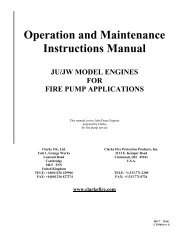manual for model fd4 fire pump controllers - Steven Brown ...
manual for model fd4 fire pump controllers - Steven Brown ...
manual for model fd4 fire pump controllers - Steven Brown ...
You also want an ePaper? Increase the reach of your titles
YUMPU automatically turns print PDFs into web optimized ePapers that Google loves.
PART V: ADDITIONAL OPTIONAL FEATURES<br />
A. Battery Charger Operation: The Battery Chargers are mounted in the engine controller, and are factory wired to the controller<br />
terminal block from which it obtains its 120 volt, 50-60 Hz. supply voltage, and through which it provides charging current to<br />
the batteries. The charging current to the two (2) batteries and the battery voltage is monitored by the controller and displayed<br />
on the OID. The charger output is current limited and provides full protection during the engine cranking cycle. The charger<br />
input and output are fused <strong>for</strong> protection in case of a failure of the control circuit or other internal component.<br />
Each battery charger is fully automatic, and will charge the batteries at a rate of up to 10 amperes. As the batteries approach full<br />
charge, the current will taper off to a predetermined level at which time the charger automatically switches to the float mode of<br />
operation. In the float mode the charger maintains the batteries at the float potential (approximately 12.7 volts <strong>for</strong> a 12-volt<br />
battery or 25.4 volts <strong>for</strong> the 24-volt battery).<br />
The charger provides a means of monitoring the charger output to sound an alarm in case of loss of charger output. This also<br />
provides a means of monitoring the A.C. power since a loss of A.C. power results in a loss of charger output.<br />
In the event that a battery is lost or disconnected the output of the charger will stop (0 volts). This will allow the voltage sensing<br />
circuit of the <strong>fire</strong> <strong>pump</strong> controller microprocessor to detect a missing battery or open circuit from the battery. This will result in<br />
the respective Battery Fault light to illuminate and the alarm horn to sound. The battery must be connected to the controller to<br />
reset the alarm.<br />
Generally, when all conditions are normal, the batteries will come to a full charge prior to the 24 hour period. As batteries begin<br />
to charge, the controller OID will indicate a gradual decrease in current flow. When these ammeters indicate a current level of<br />
less than 0.5 amps the charger will be in a trickle mode.<br />
Check batteries daily <strong>for</strong> a few days after initial installation has been made, and weekly thereafter. Batteries should be checked<br />
<strong>for</strong> overcharging (gassing), or undercharging (low voltage, or low specific gravity of the electrolyte or acid.<br />
CAUTION: Under no circumstances should new electrolyte (acid) be added to a battery that has been previously filled.<br />
Only distilled water is recommended <strong>for</strong> maintenance purposes.<br />
Page 8 of 25<br />
File Name: Doc#586C.doc



